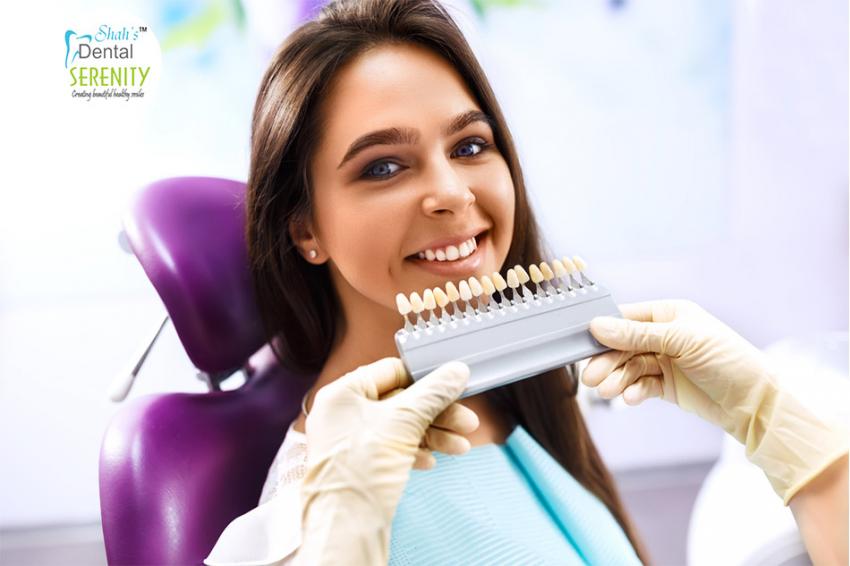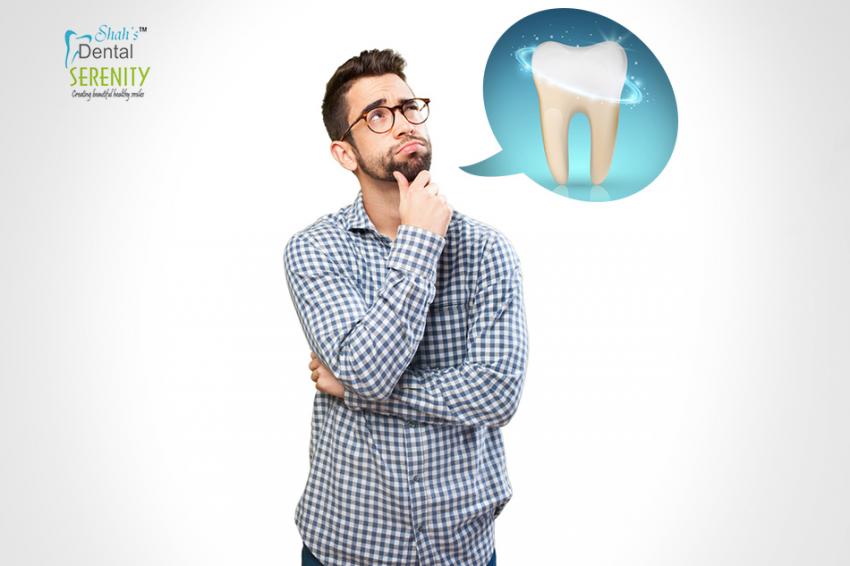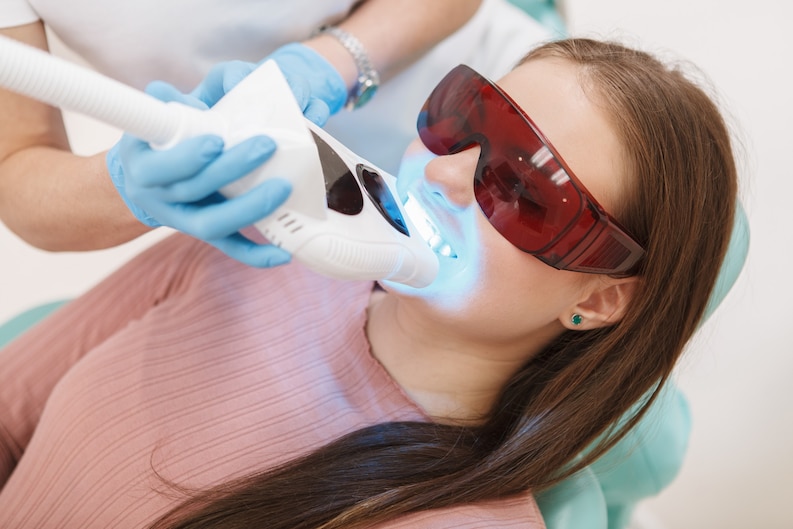Introduction
Teeth whitening is a cosmetic dental procedure that aims to remove stains and discoloration from teeth and make them look brighter and whiter. A bright smile can greatly improve one’s self-confidence and overall appearance. With the increasing demand for whiter teeth, there has been a rise in the number of teeth whitening products and treatments available.
In this blog, we will be exploring the different teeth whitening methods available and help you determine which one is right for you. We will be discussing at-home whitening products such as teeth whitening strips and trays, in-office treatments like power bleaching and laser whitening, and natural alternatives like baking soda and oil pulling.
It’s important to keep in mind that not all teeth whitening methods are suitable for everyone and that you should consult with your dentist before undergoing any whitening treatment. Your dentist can assess your dental health, take into account any previous dental procedures you may have had, and recommend the best whitening method for you.
A. Definition of Teeth Whitening
Teeth whitening is a cosmetic dental procedure that involves removing surface and deep stains from teeth, resulting in a brighter and whiter smile. This can be achieved through a variety of methods including the use of whitening gels, laser treatment, and at-home whitening kits.
B. Importance of a Bright Smile
A bright and white smile can have a significant impact on one’s overall appearance and self-confidence. It can also improve a person’s first impression on others and boost their social and professional life. Additionally, a bright smile can also make a person appear more approachable and friendly.
C. Overview of different teeth whitening methods
There are several methods of teeth whitening available, including:
- At-home teeth whitening products such as teeth whitening strips and trays.
- In-office treatments like power bleaching and laser whitening.
- Natural teeth whitening alternatives such as baking soda and oil pulling.
Each method has its own advantages and disadvantages and it’s important to consider factors such as cost, effectiveness, and dental health before choosing the right method for you. In the next sections, we will explore each of these methods in detail to help you make an informed decision.
At-Home Teeth Whitening
At-home teeth whitening products offer a convenient and affordable way to achieve a brighter and whiter smile. The following are some of the most popular at-home teeth whitening options:
A. Teeth Whitening Strips
Teeth whitening strips are thin, flexible strips coated with a hydrogen peroxide-based gel. The strips are placed on the front surface of the teeth and left in place for a specified amount of time, usually 30 minutes to an hour. The hydrogen peroxide in the gel is said to penetrate the enamel and remove surface and deep stains from the teeth.
B. Teeth Whitening Trays
Teeth whitening trays are similar to strips, but they are worn over the entire arch of the teeth. The trays are filled with a hydrogen peroxide-based gel and placed over the teeth for a specified amount of time. Like strips, the hydrogen peroxide in the gel is said to penetrate the enamel and remove surface and deep stains from the teeth.
C. Teeth Whitening Toothpastes
Teeth whitening toothpastes are regular toothpastes that contain mild abrasives and whitening agents to remove surface stains. The toothpastes work by gently scrubbing the teeth to remove surface stains, and the whitening agents help to break down deeper stains. Tooth whitening toothpastes are a good option for those who want a more natural approach to whitening their teeth and for those who have sensitive teeth or gum issues.
Pros and Cons of At-Home Teeth Whitening
Pros:
- Convenient and easy to use.
- More affordable than in-office treatments.
- Can be used in the comfort of your own home.
Cons:
- Results may not be as noticeable as in-office treatments.
- May not be suitable for those with sensitive teeth or gum issues.
- The strength of the whitening agents used in at-home products is limited, so they may take longer to produce results.
It’s important to note that it’s always a good idea to consult with your dentist before starting any at-home whitening treatment, especially if you have any pre-existing dental health issues. Your dentist can assess your dental health and determine if at-home whitening is right for you.
In-Office Teeth Whitening
In-office teeth whitening treatments are performed by a dental professional in a dental office. The treatments use a higher concentration of hydrogen peroxide or other whitening agents to achieve a brighter and whiter smile in a shorter amount of time compared to at-home treatments.
The following are some of the most popular in-office teeth whitening options:
A. Power Bleaching
Power bleaching is an in-office teeth whitening treatment that uses a combination of heat, light, and hydrogen peroxide-based gel to penetrate the enamel and remove deep stains. The treatment is said to provide long-lasting results, and it typically takes several hours to complete. Power bleaching is a good option for those with deep and stubborn stains that have not responded to other whitening treatments.
B. Laser Teeth Whitening
Laser teeth whitening is an in-office teeth whitening treatment that uses a laser light to activate the hydrogen peroxide-based gel and accelerate the whitening process. The treatment is said to take about an hour and can provide noticeable results in just one visit. Laser teeth whitening is a good option for those who want faster and more noticeable results compared to at-home treatments.
C. Pros and Cons of In-Office Teeth Whitening
Pros:
- Faster and more noticeable results compared to at-home treatments.
- Performed by a dental professional for added safety and comfort.
- Stronger whitening agents are used for deeper and longer-lasting results.
Cons:
- More expensive than at-home treatments.
- Requires a dental appointment and cannot be performed at home.
- May not be suitable for those with sensitive teeth or gum issues.
As with at-home treatments, it’s important to consult with your dentist before starting an in-office whitening treatment, especially if you have any pre-existing dental health issues. Your dentist can assess your dental health and determine if in-office whitening is right for you.
Natural Teeth Whitening Alternatives
For those who prefer a more natural approach to teeth whitening, there are several alternative options that can help to brighten your smile without the use of harsh chemicals.
A. Baking Soda and Lemon Juice
Baking soda and lemon juice is a popular natural teeth whitening solution that can help to remove surface stains and brighten the teeth. The mixture is made by mixing equal parts baking soda and lemon juice to create a paste. The paste is then applied to the teeth and left for several minutes before rinsing. This treatment can be repeated up to twice a week for best results.
B. Oil Pulling
Oil pulling is an ancient practice that involves swishing oil (such as coconut oil) in the mouth for several minutes to remove bacteria and toxins from the teeth and gums. Some people claim that oil pulling can also help to whiten the teeth, although there is limited scientific evidence to support this. To try oil pulling, simply place a tablespoon of oil in your mouth and swish it around for several minutes before spitting it out and rinsing with water.
C. Eating Crunchy Fruits and Vegetables
Eating crunchy fruits and vegetables can help to naturally whiten your teeth by removing surface stains and promoting healthy chewing habits. Foods such as apples, carrots, and celery can help to scrub the teeth and freshen the breath.
Pros and Cons of Natural Teeth Whitening Alternatives
Pros:
- Made with natural ingredients that are safe for the teeth and gums.
- Affordable and easily accessible.
- Can be performed in the comfort of your own home.
Cons:
- Results may not be as noticeable as those from professional treatments.
- Can take longer to see results compared to professional treatments.
- May not be effective for those with deep or stubborn stains.
It’s important to note that these natural alternatives may not be suitable for everyone, and it’s always best to consult with your dentist before starting a new whitening regimen. Your dentist can assess your dental health and help determine the best whitening solution for you.
Factors to Consider When Choosing a Teeth Whitening Method
When it comes to choosing a teeth whitening method, there are several factors to consider to ensure you choose the right solution for your needs.
A. Cost
Teeth whitening treatments can vary greatly in cost, from affordable at-home treatments to more expensive in-office treatments. Consider your budget and any insurance coverage you may have when choosing a whitening method.
B. Convenience
Consider how much time you have available to devote to whitening your teeth. At-home whitening treatments can be done on your own schedule, but they may take several weeks to several months to produce noticeable results. In-office treatments can produce results in a single visit, but they can be more expensive and may not be covered by insurance.
C. Effectiveness
Different whitening methods are designed to target different types of stains. Consider the type of stains you have and your goals for whitening your teeth when choosing a method.
D. Dental Health
Before starting any whitening treatment, it’s important to consult with your dentist to ensure that your teeth and gums are healthy enough to undergo the treatment. This is especially important for those with sensitive teeth or gum problems, as some whitening treatments can exacerbate these issues.
Ultimately, the best whitening method for you will depend on your personal preferences and goals, including your budget, lifestyle, and the type of results you are looking for. Discuss your options carefully with your dentist to determine the best solution for you.
Conclusion
In conclusion, there are several options available for achieving a brighter, whiter smile, including at-home treatments, in-office treatments, and natural alternatives. When choosing a teeth whitening method, it’s important to consider factors such as cost, convenience, effectiveness, and dental health.
Regardless of the method you choose, it’s always recommended to consult with your dentist before starting any whitening treatment. Your dentist can help you determine the best solution for your needs and ensure that your teeth and gums are healthy enough to undergo the treatment.
In the end, a bright, white smile can greatly enhance your confidence and appearance, and with the right whitening solution, you can achieve the results you’re looking for.
A. Recap of different teeth whitening methods
In this blog, we’ve explored several different teeth whitening methods, including:
Each method has its own advantages and disadvantages, and the best solution for you will depend on your individual needs and goals.
B. Importance of consulting a dentist before whitening teeth
Before starting any teeth whitening treatment, it’s important to consult with your dentist. This will help ensure that your teeth and gums are healthy enough to undergo the treatment, and can also help you determine the best solution for your needs. Your dentist can also provide advice on how to maximize the results of your whitening treatment and help you avoid any potential complications.
C. Final thoughts on choosing the right teeth whitening method
In conclusion, there are several effective options available for achieving a brighter, whiter smile. When choosing a teeth whitening method, it’s important to consider factors such as cost, convenience, effectiveness, and dental health. By working closely with your dentist, you can find the solution that’s right for you and enjoy a brighter, more confident smile.




